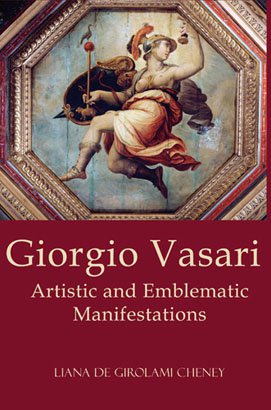
About the Author
Liana De Girolami Cheney, Professor of Art History, Chairperson of the Department of Cultural Studies at the University of Massachusetts Lowell, is author and coauthor of numerous books and articles, including, Botticelli’s Neoplatonic Images; Neoplatonism and The Arts; The Paintings of the Casa Vasari; Readings in Italian Mannerism; The Symbolism of Vanitas in the Arts; Self-Portraits of Women Painters; Essays of Women Artists: ‘The Most Excellent’; Andrea del Verrocchio’s Celebration: 1435-1488; Medievalism and Pre-Raphaelitism; Neoplatonic Aesthetics in Literature, Music and the Visual Arts; Giorgio Vasari’s Teachers: Sacred and Profane Art; Giuseppe Arcimboldo; The Religious Architecture of Lowell; The Homes of Giorgio Vasari (Le dimore di Giorgio Vasari); Giorgio Vasari’s Prefaces: Art and Theory.
GIORGIO VASARI: Artistic and Emblematic Manifestations
Liana De Girolami CheneyNew Academia Publishing, 2011
502 Pages, 250 Illustrations
ISBN 978-0-9845832-3-2 Paperback
For BULK ORDERS, order directly from New Academia Publishing.
Queries: orders@newacademia.com
About the Author
Liana De Girolami Cheney, Professor of Art History, Chairperson of the Department of Cultural Studies at the University of Massachusetts Lowell, is author and coauthor of numerous books and articles, including, Botticelli’s Neoplatonic Images; Neoplatonism and The Arts; The Paintings of the Casa Vasari; Readings in Italian Mannerism; The Symbolism of Vanitas in the Arts; Self-Portraits of Women Painters; Essays of Women Artists: ‘The Most Excellent’; Andrea del Verrocchio’s Celebration: 1435-1488; Medievalism and Pre-Raphaelitism; Neoplatonic Aesthetics in Literature, Music and the Visual Arts; Giorgio Vasari’s Teachers: Sacred and Profane Art; Giuseppe Arcimboldo; The Religious Architecture of Lowell; The Homes of Giorgio Vasari (Le dimore di Giorgio Vasari); Giorgio Vasari’s Prefaces: Art and Theory.
About the book
The essays in this book examine art historical manifestations observed in Giorgio Vasari’s paintings and writings, including his impact in the emblematic tradition. Vasari’s conception of history painting evolves in the development of religious and secular decorative cycles in the sixteenth century. His classical education, his love for collecting art and his quest for artistic expression through disegno (drawing) reveal his humanistic culture. Vasari fuses the classical artistic, literary and philosophical traditions with Renaissance literary and visual conventions, thus formulating a practical and theoretical artistic language as well as a historical visual and emblematic repertoire of images with their significance.





 Coming Soon
Coming Soon Awards
Awards